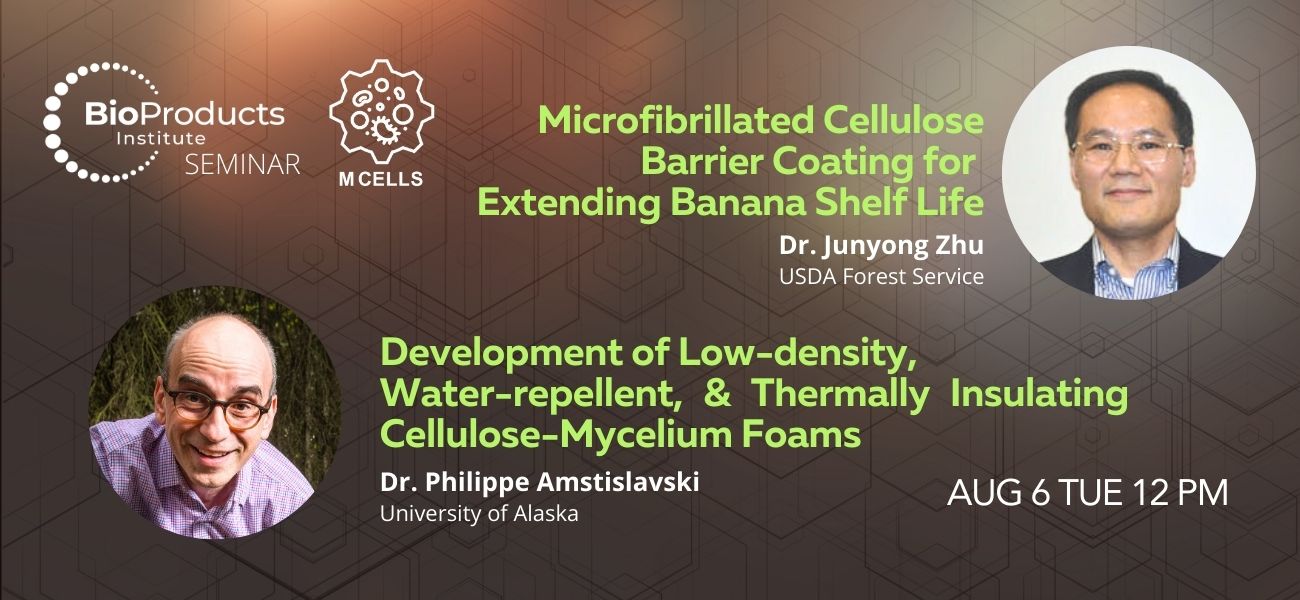BPI-MCELLS Seminar by Drs. Junyong Zhu & Philippe Amstislavski
August 6, 2024, 12:00 pm to 1:30 pm
Location: CHBE #202, 2360 East Mall Vancouver BC V6T 1Z4
Agenda
- 12:00 PM Intro by Prof. Orlando Rojas
- 12:05 PM Microfibrillated Cellulose Barrier Coating for Extending Banana Shelf Life by Dr. Junyong Zhu, USDA Forest Service, Forest Products Lab., Wisconsin
- 12:45 PM Development of Low-density, Water-repellent, and Thermally Insulating Cellulose-Mycelium Foams by Dr. Philippe Amstislavski, University of Alaska
- 1:25 PM Q&A
Microfibrillated Cellulose Barrier Coating for Extending Banana Shelf Life - Dr. Junyong Zhu
In this seminar, Dr. Zhu will discuss two subjects on production and utilization of microfibrillated cellulose (MFC). In the first subject his team conducted a detailed evaluation of the feasibility of producing microfibrillated cellulose (MFC) from a kraft bleached hardwood pulp at high solids loadings with and without pretreatments in a planetary ball mill. MFCs produced by ball milling at solids loading at 17% and 28% were compared with those from 1% and 5%. They identified two mechanisms of fiber fibrillation: (i) ball and fiber/fibril interactions as the primary mechanism and (ii) inter-fiber/fibril frictional and tensional interactions as the secondary mechanism. High solids loading with both mechanisms (i) and (ii) enhanced fiber fibrillation, especially in the early stage of milling. Fiber pretreatments using a commercial endoglucanase and mechanical refining using a laboratory PFI mill were also applied before ball milling at solids loading of 28%. Mechanical refining of fibers facilitated fibrillation to result in MFCs with a morphology similar to that from fibers without any pretreatment but for a much shorter ball milling time.
In the second subject, the team evaluated the feasibility of using microfibrillated cellulose (MFC) for barrier coating to preserve the shelf life of bananas. The performance of barrier coating on banana peel surface was evaluated from visual observations, banana weight loss, firmness, and dissolved soluble sugars content. The results indicate that coating with 100% MFC on banana peel surface decreased banana weight (water) loss delayed the banana softening, and conversion of banana carbohydrates into soluble sugars. Furthermore, the extent of mechanical fibrillation in producing MFC affected MFC suspension wettability of banana peel surface, as well as the effectiveness of banana preservation. The effects of the extent of MFC fibrillation were found to be more effective than increasing the amount of coating in reducing water vapor permeation for better fruit protection.
About the Speaker
Dr. J.Y. Zhu is a scientific leader at the USDA Forest Products Laboratory, Madison, Wisconsin. Currently, he holds an adjunct appointment at the University of Wisconsin-Madison and the University of Maryland-College Park. He was the inaugural Fulbright-Aalto University Distinguished Chair in Energy and Sustainable Use of Natural Resources (2015-2016), Helsinki, Finland. He has co-authored over 250 peer referred papers and over a dozen of US patents. His work is frequently cited by the broad scientific community with google scholar citations over > 25,000 and an h index of 78. His scientific accomplishments were honored with many national and international awards, including AIChE (American Institute of Chemical Engineers) Andrew Chase award in 2016. USDA Undersecretary and US Forest Service Chief’s honor award in 2019, and the Scientific Achievement Award by the International Union of Forest Research Organizations (IUFRO) in 2019. Dr. Zhu is a Fellow of AIChE, TAPPI, and IAWS (International Academy of Wood Science).
Development of Low-density, Water-repellent, and Thermally Insulating Cellulose-Mycelium Foams - Dr. Philippe Amstislavski
This work explored whether partial cellulose bioconversion with fungal mycelium can improve the properties of cellulose fibre-based materials. We demonstrate an efficient approach for producing cellulose-mycelium composites utilizing several cellulosic matrices and show that these materials can match fossil-derived polymeric foams on water contact angle, compression strength, thermal conductivity, and exhibit selective antimicrobial properties. Fossil-based polymeric foams commonly used for these applications are highly carbon positive, persist in soils and water, and are challenging to recycle. Bio-based alternatives to synthetic polymers could reduce GHG emissions, store carbon, and decrease plastic pollution. We explored several fungal species for the biofabrication of three kinds of cellulosic-mycelium composites and characterized the resulting materials for density, microstructure, compression strength, thermal conductivity, water contact angle, and antimicrobial properties. Foamed mycelium-cellulose samples had low densities (0.058 – 0.077 g/cm3), low thermal conductivity (0.03 – 0.06 W/m∙K at +10 °C), and high water contact angle (118 – 140°). The recovery from compression of all samples was not affected by the mycelium addition and varied between 70% and 85%. In addition, an antiviral property against active MS-2 viruses was observed. These findings show that the biofabrication process using mycelium can provide water repellency and antiviral properties to cellulose foam materials while retaining their low density and good thermal insulation properties.
About the Speaker
Dr. Amstislavski is a Professor of Public Health at the University of Alaska and the director of the UAA Biomaterials Laboratory. His research focuses on self-assembling, carbon-negative hybrid cellulose and mycelium composites, carbon storage in bio-inspired materials, microbial control in biomedical devices and high-touch surfaces, synthetic biology, and their translational applications. He holds a PhD from CUNY and a Master’s degree from Yale University’s School of the Environment.
Dr. Amstislavski was a Fulbright Scholar in Finland in 2021-22. He currently collaborates with the National Renewable Energy Laboratory (NREL) and the VTT Technical Research Centre of Finland on various projects. Additionally, he co-leads a team in the US Department of Energy’s Advanced Research Program Agency (ARPA-E) HESTIA program (Harnessing Emissions into Structures Taking Inputs from the Atmosphere). He is also the Principal Investigator on the US National Oceanic and Atmospheric Administration-funded Marine Debris Prevention team, aiming to transition the Alaskan fishing industry to sustainable materials using cellulose-mycelium foams and composites.
